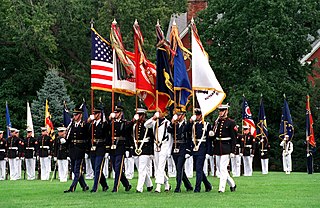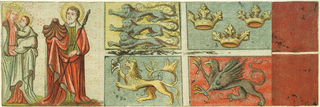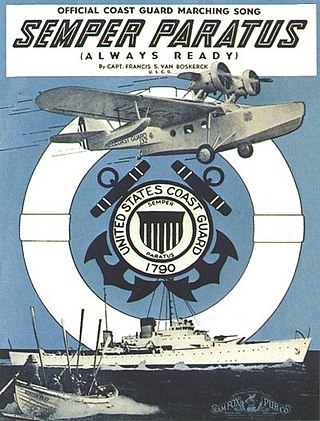
The United States Coast Guard (USCG) is the maritime security, search and rescue, and law enforcement service branch of the United States Armed Forces and one of the country's eight uniformed services. The service is a maritime, military, multi-mission service unique among the United States military branches for having a maritime law enforcement mission with jurisdiction in both domestic and international waters and a federal regulatory agency mission as part of its duties. It is one of the largest and most powerful coast guards in the world, rivaling the capabilities and size of most navies.

The national flag of Romania is a tricolour. The Constitution of Romania states that "The flag of Romania is tricolour; the colours are arranged vertically in the following order from the flagpole: blue, yellow, red". The flag has a width-length ratio of 2:3; the proportions, shades of colour as well as the flag protocol were established by law in 1994, and extended in 2001.

The national flag of Greece, popularly referred to as the "blue and white one" or the "azure and white", is officially recognised by Greece as one of its national symbols and has nine equal horizontal stripes of blue alternating with white. There is a blue canton in the upper hoist-side corner bearing a white cross; the cross symbolises Eastern Orthodox Christianity. The blazon of the flag is Azure, four bars Argent; on a canton of the field a Greek cross throughout of the second. The official flag ratio is 2:3. The shade of blue used in the flag has varied throughout its history, from light blue to dark blue, the latter being increasingly used since the late 1960s. It was officially adopted by the First National Assembly at Epidaurus on 13 January 1822. The nine stripes do not have any official meaning; the most popular theory says that they represent the syllables of the phrase Ελευθερία ή Θάνατος, the five blue stripes for the syllables Ελευθερία and the four white stripes ή Θάνατος. The nine stripes is also said to represent the letters of the word "freedom" . White and blue symbolise the colours of the Greek sky and sea.

The several branches of the United States Armed Forces are represented by flags. Within the U.S. military, various flags fly on various occasions, and on various ships, bases, camps, and military academies.

The flag of the United States Marine Corps is the flag used to represent the U.S. Marine Corps, as well as its subsidiary units and formations.

A maritime flag is a flag designated for use on ships, boats, and other watercraft. Naval flags are considered important at sea and the rules and regulations for the flying of flags are strictly enforced. The flag flown is related to the country of registration: so much so that the word "flag" is often used symbolically as a metonym for "country of registration".

The United States Customs Service was the very first federal law enforcement agency of the U.S. federal government. Established on July 31, 1789, it collected import tariffs, performed other selected border security duties, as well as conducted criminal investigations.

The commissioning pennant is a pennant flown from the masthead of a warship. The history of flying a commissioning pennant dates back to the days of chivalry with their trail pendants being flown from the mastheads of ships they commanded. Today, the commissioning pennants are hoisted on the day of commissioning and not struck until they are decommissioned. Some navies have a custom of flying a "paying off" or "decommissioning pennant," the length of which often reflects the length of service of the warship.

The First Navy Jack was the naval jack of the United States from 1975 to 1976 and again from 2002 to 2019. It was authorized by the U.S. Navy and was flown from the jackstaff of commissioned vessels of the U.S. Navy while moored pierside or at anchor. Since then, it is used only as a naval jack by the oldest active warship in the U.S. Navy. The design is traditionally regarded as that of the first U.S. naval jack, flown soon after independence, but this is not supported by the historical record.

In military organizations, the practice of carrying colours, standards, flags, or guidons, both to act as a rallying point for troops and to mark the location of the commander, is thought to have originated in Ancient Egypt some 5,000 years ago. The Roman Empire also made battle standards, reading SPQR a part of their vast armies. It was formalized in the armies of Europe in the High Middle Ages, with standards being emblazoned with the commander's coat of arms.

The jack of the United States, referred to as the Union Jack by the U.S. Navy, is a maritime jack flag flown on the bow of U.S. vessels that are moored or anchored. In addition to commissioned U.S. Navy ships, the jack is used by the U.S. Coast Guard, the Military Sealift Command, the ships of the National Oceanic and Atmospheric Administration, and other U.S. government entities. While anchored or moored, the jack is flown on the bow of a ship, and the ensign is flown on the stern. Once under way, the jack is lowered.

The flag of the United States Navy consists of the seal of the U.S. Department of the Navy in the center, above a yellow scroll inscribed "United States Navy" in dark blue letters, against a dark blue background.

The ensign of the United States is the flag of the United States when worn as an ensign. International maritime law—see International Treaty on Law of the Sea, articles 91 and 92—provides that vessels have a "national character" and thus should display a flag (ensign) that corresponds to this national character, especially when in international or foreign waters. Vessels that are formally documented under the federal vessel documentation act, vessels owned by government bodies in the United States, and vessels in the U.S. military unquestionably have U.S. national character, and thus properly hoist a U.S. ensign to show their national character. Vessels that are numbered by the states and small, non-registered craft owned by U.S. citizens and not registered in other countries may also hoist a U.S. ensign to show their national character.

"Semper Paratus" is a 1928 song and the official march of the United States Coast Guard, having been composed in 1927 by U.S. Coast Guard Captain Francis Saltus Van Boskerck.
The United States Revenue Cutter Ingham was one of the 13 Coast Guard cutters of the Morris-Taney class. Named for Secretary of the Treasury Samuel D. Ingham, she was the first United States warship to engage a Mexican ship in combat; and for her service in that battle, a newspaper called her Semper Paratus, which later became the motto of the United States Coast Guard. Ingham was sold in 1836 to the Republic of Texas and served in the Texas Navy until she was captured as a prize-of-war by Mexico and was rechristened Independencia.
USRC Eagle was one of the first ten cutters operated by the United States Revenue-Marine, which later became the United States Revenue Cutter Service and later still became part of the United States Coast Guard.

The flag of the president of the United States consists of the presidential coat of arms on a dark blue background. While having the same design as the presidential seal since 1945, the flag has a separate history, and the designs on the flag and seal have at different times influenced each other. The flag is often displayed by the president in official photos, or flown next to the casket of a former president in official funeral processions, and flown on the president's motorcade. The flag is not flown at half-staff since there is always an incumbent president in office. The current flag is defined in Executive Order 10860:
The Color and Flag of the President of the United States shall consist of a dark blue rectangular background of sizes and proportions to conform to military and naval custom, on which shall appear the Coat of Arms of the President in proper colors. The proportions of the elements of the Coat of Arms shall be in direct relation to the hoist, and the fly shall vary according to the customs of the military and naval services.

USRCSurveyor was a ship of the United States Revenue Marine captured by the United Kingdom during the War of 1812. Despite the vessel's loss, the "gallant and desperate" defense of her crew against a superior force of the Royal Navy and the Corps of Royal Marines is commemorated by the United States Coast Guard. Along with the Royal Navy frigate which bested her in battle, HMS Narcissus, Surveyor is among six legendary ships memorialized in the lyrics of the Coast Guard march "Semper Paratus".

The defense of the cutter Eagle was a battle on and around Long Island New York, that took place from October 10 to 13, 1814, between the British Royal Navy and the United States' Revenue Marine. Early on in the engagement, the United States' only involved vessel, USRC Eagle, was beached near Negro Head. Despite the loss of their ship, her crew continued fighting the Royal Navy vessels from shore using cannon recovered from their wrecked vessel. Eagle's crew was ultimately able to repair and refloat her, but unsuccessful in their attempts to drive the British ships away. Once more she was beached, but after exhausting their ammunition over three days of fighting, the Eagle's crew was unable to prevent her from being towed off by the Royal Navy, which then sailed her back past the shoreline for a victory lap. Though there were no fatalities on either side in the battle, a cow grazing in the area died after being hit by a 32-pound (15 kg) round shot fired by one of the Royal Navy ships.

Francis Saltus Van Boskerck was a United States Coast Guard captain known for writing and composing Semper Paratus, the Coast Guard's official march. He held various senior positions within the Coast Guard.




















